IN THIS ISSUE
- Mussel invaders found in moss balls
- When right whale threats end in death
- Eagle nest failures and a turkey takedown
- The amazing moth life at Sandhills West
 Prothonotary warbler (Tom Wilson/GNPA)
When filing your Georgia income taxes, remember that contributing via the Georgia Wildlife Conservation Fund checkoff is a fast, effective way to conserve wildlife.
Donations large and small help, and giving is easy. Just fill in any amount of a $1 or more on line 30 of form 500 or line 10 of form 500-EZ.
Contributions are used to restore, research and raise awareness of native species, from gopher tortoises to prothonotary warblers and endangered Canby’s dropwort.
This work is paid for largely through grants and fundraisers. The checkoff has been a vital fundraiser for 30-plus years. Learn more, and see how contributions are used.
Also worth noting: This year's filing deadline for individuals has been moved from April 15 to May 17.
ALREADY FILED?
Give year-round at gooutdoorsgeorgia.com (click “Licenses & Permits” to log in or create an account) or donate directly. Details at georgiawildlife.com/donations.
Top
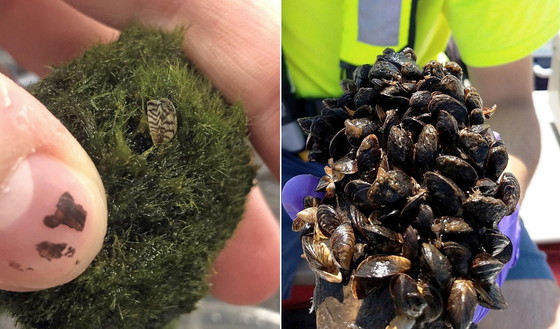 Zebra mussels, from moss balls to masses (USGS; right photo by John Byrnes/USGS)
When invasive zebra and quagga mussels were found in moss balls sold at pet stores across the nation, DNR joined other wildlife agencies in urging residents to remove and properly dispose of the plant products.
The reason: These finger nail-sized mussels native to eastern Europe are bad news.
Established in the Great Lakes and many other U.S. waters, both species multiply fast, foul boats, clog water intake pipes, filter out algae native that wildlife need and outcompete native mussels.
Georgia has no known populations. DNR Aquatic Nuisance Species Coordinator Jim Page is hoping with the public’s help to "keep that streak going.”
How to: properly dispose of moss balls
Top
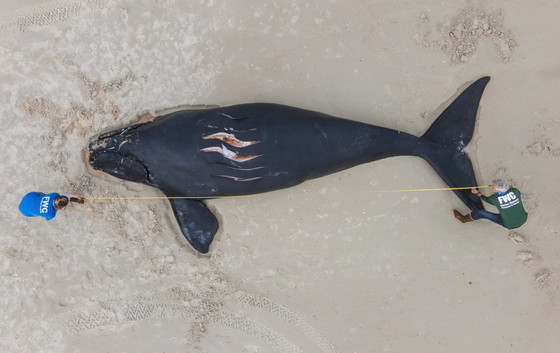 Measuring the calf killed by boat strike (Tucker Joenz/Florida FWC, NOAA permit 18786)
Death came quickly for the calf.
For the adult nicknamed Cottontail, it took months.
There are fewer than 375 North Atlantic right whales left. The two leading threats pushing them ever closer to extinction are entanglement in commercial fishing gear and being hit by ships and boats.
Within two weeks last month, the Southeast coast saw right whales die from both.
The incidents provided a grim look at the risk right whales live, and die, with. …
Read about the plight of Cottontail and the calf in this DNR blog post.
FOR MORE
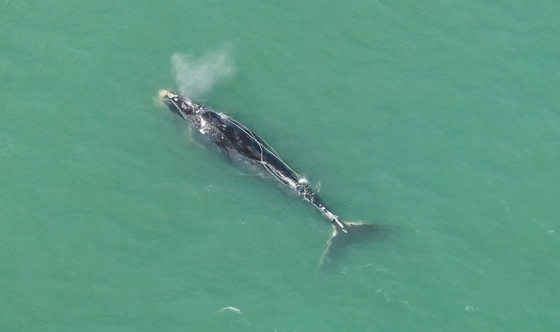 Cottontail trailing rope off Indialantic Beach, Fla. (Joey Antonelli/Florida FWC, NOAA permit 18786)
WHAT YOU CAN DO
CALVING CLOSEOUT
- The survey season for calves in the Southeast ends March 31.
- Seventeen mom/calf pairs were seen this winter. An 18th calf found on a North Carolina beach in November likely died during birth or shortly after.
- Although shy of the 22-a-year average from 2000-2009, the 17 calves are the most since 2015. Only 22 total were spotted over the last four winters.
- It is possible some calves were missed in the Southeast and will be seen in New England or Canadian waters, where they’ll migrate with their mothers.
Top
 Bald eagle near Lake Allatoona (Ron Goldfarb)
For good and bad, eagles have been drawing attention recently. Here's an overview.
Lead poisoning: Last month's discovery of a dying bald eagle apparently peppered with lead shot spurred calls to find the shooter. But there wasn’t one.
While X-rays revealed the pellets, further analysis showed they were actually in the eagle’s gizzard. The bird died of lead poisoning, probably from eating a live waterbird or dead animal with the pellets in it.
DNR’s Dr. Bob Sargent, a Wildlife Conservation Section program manager, said that although lead exposure in Georgia eagles appears to be uncommon and lead toxicity is rare, lead is often detected in necropsies, or animal autopsies, of dead eagles collected from other parts of the Southeast.
“It takes a very small amount – on the order of the size of a fingernail – to debilitate an animal long-term or to kill it,” Sargent said.
Eagles most often ingest lead by eating live waterbirds or carrion containing lead shot or fragments. There are, though, other sources of lead in the environment, such as paint, batteries and industrial waste.
The lead ingested by birds of prey is absorbed into the bloodstream and soft tissues, where it can cause neurological, immune system and kidney problems.
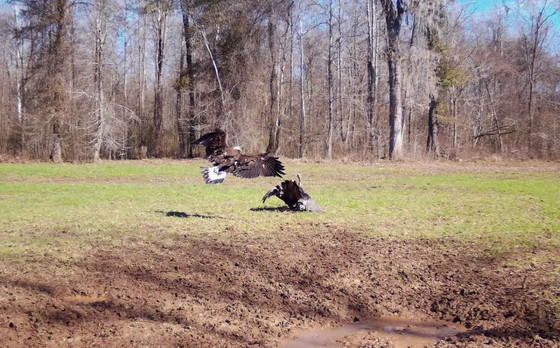 Golden eagle preying on a wild turkey (special to DNR)
Golden takedown: A game camera recently recorded an immature golden eagle attacking a turkey in Burke County. Not that tackling big prey is new for goldens.
“They’re known to take small mammals that weigh more than wild turkeys,” Sargent said.
Golden eagles are physically designed to hunt things other than fish, the favorite prey of bald eagles, he explained. They also are more secretive, and more rare in Georgia, spotted occasionally in the state from fall through winter.
Berry nest failure: The death of an eaglet and a second egg that did not hatch ended the nesting season for eagles followed on Berry College’s popular nest cam.
The adult female, new to the nest and apparently inexperienced at raising young, did not feed the chick regularly and left it uncovered during wet, cold weather. The other egg likely wasn’t viable.
Sargent, who leads DNR’s annual eagle nest surveys, said eaglet deaths and nest failures are common. About 20-30 percent of nests fail each year. With bald eagle clutches usually comprised of two eggs – three on rare occasions – the average number of young that survive to fledging is about 1.5 per nest.
The first chick to hatch usually fares better than its siblings because, given a head start, it is bigger and tends to get first dibs when parents deliver food to the nest.
But life doesn’t get easier when an eagle leaves the nest. Studies show that only 10-20 percent survive to the age of 5, which is when they reach sexual maturity and when their fully white heads and tails appear.
The good news for Berry cam fans: Inexperienced eagles learn from their mistakes raising young. Moms do a better job tearing food into small pieces for eaglets (which can't feed themselves until 5-6 weeks old), balling their feet so talons don’t puncture the eggs and gently maneuvering their feet and bodies around eggs during brooding.
Video: Berry College's Dr. Renee Carleton discusses the live-streamed eagles.
Top
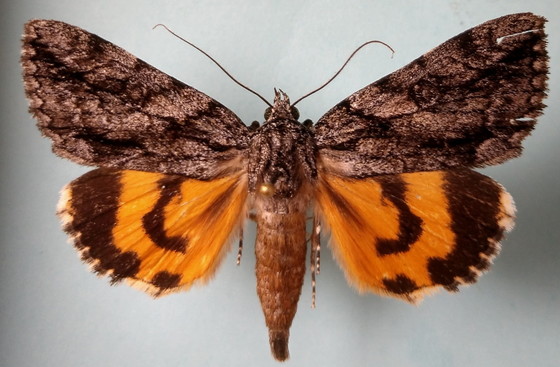 Grisatra underwing moth, a state-tracked species (James Adams/Dalton State College)
By JAMES ADAMS
In spring 2018, Nathan Klaus, a DNR senior wildlife biologist and a longtime friend, contacted me about a newly acquired state property in Taylor County.
Nathan thought I’d be interested in the moths at this unique area, now called Sandhills Wildlife Management Area: West. He was also interested in including invertebrates, for which information is typically missing, in management plans for the WMA. I readily accepted his invitation.
Over the course of 2018 and 2019, I and fellow researchers Lance Durden and Brian Scholtens visited Sandhills West 10 times. During the first trip, the variety of microhabitats and plant life was obvious. We trapped the microhabitats each time (here's a map) and not surprisingly discovered a significant diversity of moths: 535 species in all. (We predict there are actually more than 1,200.)
What was surprising, however, was the number of “special” species. We documented more than 10 moths never found in Georgia before, including two new to science and four others that are known but awaiting description. More than 20 other species recorded on the WMA were known from only five or fewer places in Georgia. And the identification of many species expanded their ranges by 100 miles or more.
We even found an abundance of some rare beetles, such as a Hypothyce species.
The moths considered “special” represented a mix of Coastal Plain specialists such as the yellow-edged pygarctia, western elements (including Metarranthis mollicularia and the white-flower moth), Floridian elements like spinose flower moth, and even northern elements such as the arched hooktip. Habitat specialists included the long-streaked tussock moth in cane, the consular (Florida) oakworm and several other species in oak savanna/sand prairies, a new Metarranthis species and a new genus notodontid species in wetland areas, and previously undescribed Dyspyralis and Schizura species in mature mixed forests.
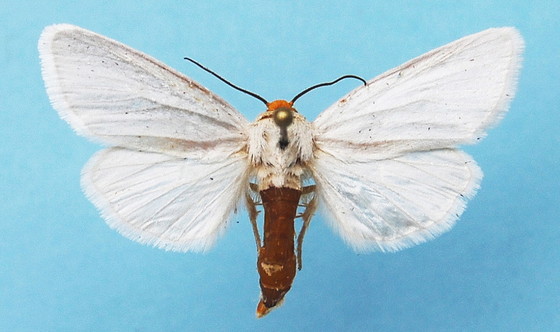 White-flower moth, documented for the first time in Georgia (James Adams/Dalton State College)
Two of the moths found are tracked by the state – the grisatra underwing moth and the gopher tortoise burrow erebid moth (their larvae feed on plant and fungus debris, and even tortoise droppings, inside gopher tortoise burrows). Sandhills West actually has the state’s only known population of grisatra underwing moths, although undoubtedly there are others.
While 10 visits might sound like a lot, we have only scratched the surface at the WMA. We have not even sampled there in the spring yet.
Beyond revealing how unique this site is, the take-home message from our preliminary work underscores the importance of variety in microhabitats for species richness – for moths and other animal groups – and the value of surveying and considering microhabitats in management plans for conservation lands.
Watch: slideshow of Sandhills West moths
FOR MORE
Drs. James K. Adams, Lance A. Durden and Brian Scholtens are professors, respectively, at Dalton State College, Georgia Southern University and College of Charleston.
Top
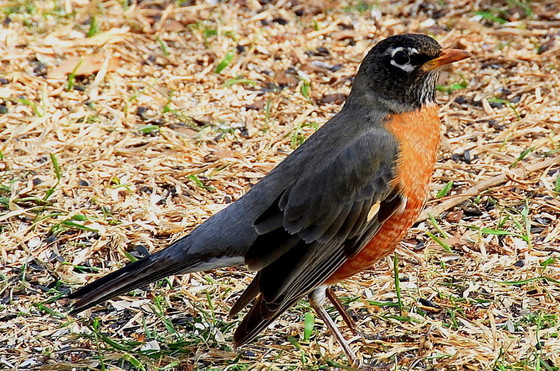 Welcomed birds, though not a harbinger of spring (Terry W. Johnson)
By TERRY W. JOHNSON
As far as Georgia winters go, 2020-2021 hasn’t been too bad. But combined with the pandemic, it seemed long and bleak and left us all longing for signs of spring.
Many Americans believe that seeing a flock of robins descend on their backyard is one of those signs. However, those of us who have lived most of our lives in the Peach State realize that’s not the case.
In truth, we are far more likely to see more robins in winter than in spring, summer and fall combined. …
Read Terry’s column to learn more about these seemingly familiar birds.
Terry W. Johnson is a retired DNR program manager and executive director of TERN, the Wildlife Conservation Section’s friends group. Check out past columns, his Backyard Wildlife Connection blog and his book “A Journey of Discovery: Monroe County Outdoors.” His columns are also featured at DNR’s blog, under the Conservation tab. Permission is required to reprint any of Terry’s columns.
Top
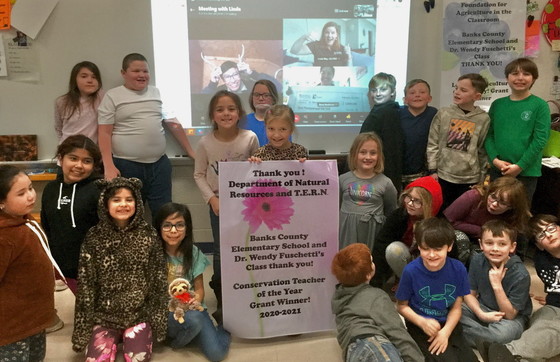 Wendy Fuschetti's students celebrate the grant news by Skype (Banks County Elementary)
A Banks County teacher’s proposal to create a wildlife garden and outdoor classroom has earned her the DNR Conservation Teacher of the Year grant. Dr. Wendy Fuschetti will use the $1,000 for a Learning in the Lab of Life in which third-graders will plan, design and install the garden and classroom area.
Pick up a poster of Georgia’s worst aquatic invaders, plus another of native fish you don’t want to move between watersheds, at DNR Wildlife Resources Division offices, education centers and public fishing areas (you can also download them). There’s even a free educational workbook on aquatic nuisance species.
Conserve Georgia grants will provide nearly $20.6 million for parks, trails and wildland projects. The nine picked for the final application stage this year include $4.6 million for DNR’s Wildlife Resources Division to acquire 11,600 acres in Camden County – the second phase of Ceylon Wildlife Management Area – $635,600 for Tall Timbers Research to buy a 444-acre conservation easement protecting Birdsong Nature Center in Grady County and almost $2 million for The Nature Conservancy to buy and begin restoring a 2,351-acre addition to the Dugdown Corridor, a priority conservation area in northwest Georgia.
Top
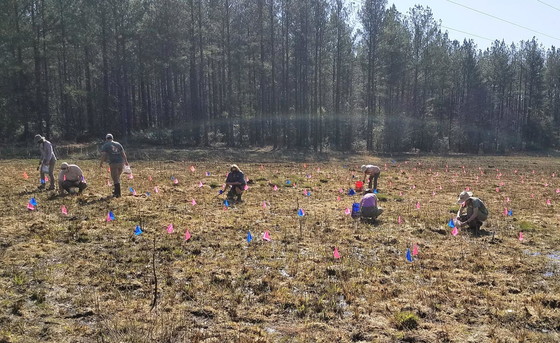 Planting at Ohoopee Dunes (Lisa Kruse/DNR)
More than 500 purple honeycomb heads, wireleaf dropseed and yellow coneflowers were recently planted at Ohoopee Dunes Wildlife Management Area. The project on the Emanuel County WMA, which later added Georgia buckthorn, pondberry and pondspice, will help restore and safeguard the rare plant species.
The 2021 Youth Birding Competition has been bumped from spring to fall and the awards banquet moved from Charlie Elliott Wildlife Center to Indian Springs State Park. Safety concerns regarding the coronavirus prompted rescheduling to Sept. 24-25 for the popular 24-hour-birdathon.
Spring means it’s time to bone up on the bear basics. Visit BearWise.org to learn about living responsibly with black bears (also follow BearWise on Facebook).
The finch irruption that swarmed feeders with pine siskins and house finches this winter is easing, hopefully resulting in fewer sick birds. However, DNR still advises regularly cleaning feeders and bird baths to lower the risk of disease.
Top
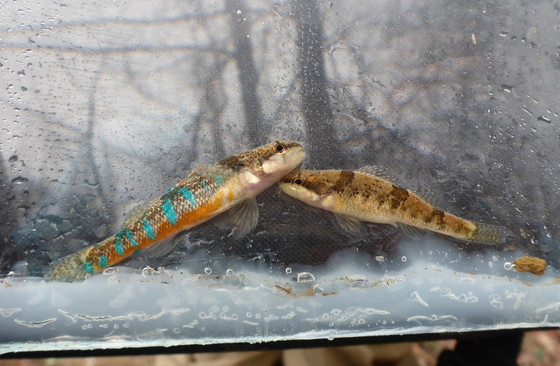 A male, left, and female trispot darter (Ani Escobar/DNR)
Extensive surveys for trispot darters upped the number of known Georgia breeding sites from one to seven. Coupled with sampling in Alabama, the data on distribution and habitats will help conserve this federally threatened fish.
Florida is banning commercial breeding of tegus and a list of other non-native reptiles, citing the ecological damage they can wreak on native wildlife. South Carolina officials responding to tegu sightings in the wild there are considering outlawing the breeding, sale and possession of the South American lizards.
DNR is investigating the poaching of an eastern indigo snake found dead on a state wildlife management area in February. Indigos are federally protected, nonvenomous and North America’s largest snake. The UGA Coastal Ecology Lab had been tracking this one, nicknamed Rocky, as part of a research project. Report tips.
Top
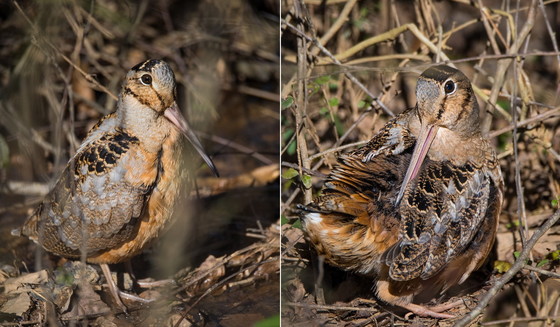 American woodcocks along the Chattahoochee River in Roswell (Ron Goldfarb)
How much wood can a woodcock – er – fly over? One American woodcock fitted with a transmitter on Clybel Wildlife Management Area near Mansfield in January 2020 migrated to New Brunswick in Canada that spring, just one of the interesting finds from continuing efforts to track these ground-loving gamebirds.
From Wolf Creek Trout Lily Preserve in Grady County to Prater’s Mill Historic Site near Varnell, the six projects recently selected for DNR Wildlife Viewing Grants promise Georgians a variety of outdoor opportunities. Plans call for new viewing platforms, upgraded trails and native plant gardens.
Prescribed fire season is on fire. Recent burns included 150 acres on Altama Plantation Wildlife Management Area near Brunswick, 600 acres – some of longleaf pine stands supporting red-cockaded woodpeckers – on Silver Lake WMA near Bainbridge, a 1,200-acre helicopter burn at West Point WMA in Troup County and a burn boosting Lake Russell WMA smooth coneflower and Georgia aster populations.
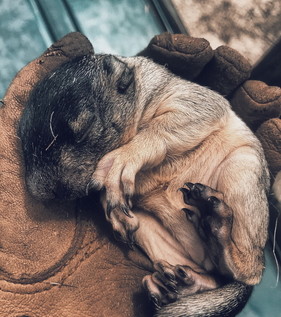
Talk about a box bonus! DNR technician Kennedy Glanton found (and returned) the fox squirrel pup at right and its sibling while checking American kestrel nest boxes in Taylor County.
A DNR and UGA crew netted 13 striped newts, including gravid females, while sampling an Alapaha River Wildlife Management Area wetland. Striped newts are a candidate for federal listing; these were the first found at the site – which is being restored – since 2017.
Names in the news: The National Fish and Wildlife Foundation presented the Guy Bradley Award posthumously to DNR Law Enforcement Division Capt. Stan Elrod, who died after being hit by a car Sept. 3. The award named for the first wildlife officer killed in the line of duty recognizes lifetime contributions for a state and a federal wildlife law enforcement employee each year. Elrod’s widow, Julie, accepted the award. Scott Robinson has been named chief of fisheries for DNR’s Wildlife Resources Division. Robinson, a 25-year employee and formerly assistant chief of fisheries, replaces Thom Litts, who was appointed the division's assistant director. The Environmental Education Alliance of Georgia honored DNR outreach coordinator Linda May for Outstanding Service to Environmental Education by an Individual. The alliance announced awards for May and others at its annual conference, held virtually this month. Breanna Bashford is the new coordinator of the Georgia R3 Initiative. The cooperative effort – R3 refers here to recruiting, retaining and reactivating hunters – is aimed at increasing participation in and acceptance of hunting and shooting sports.
|
WHAT YOU MISSED ...
In the previous Georgia Wild:
- Buyer's guide to suet and bird puddings
- Calves add up but one whale is in trouble
- See how fire is restoring Georgia forests
Top
 DNR Talking Nature Tuesday episodes: "Coyotes and Foxes," "Stranger Things"
"Bird Nesting Basics," DNR
"Sapelo Island Sounds," DNR
(podcast) "Burning While Turkeys Are Nesting," Fire University
DNR Urban Wildlife Program rescues: "Barred Owl in Screened Porch," "Elevator Shaft Snake," "Young Raccoon Freed from Jar"
"Loggerhead Sea Turtle off Little St. Simons," DNR
"Hey, Whaddaya Know? American Beech," DNR
Top
"DNR announces nine Conserve Georgia grants," AllonGeorgia
"Invasive mussel in aquarium plants could cause ‘devastating damage,’" The (Macon) Telegraph, and others
"Georgians finding sick, dead birds as finches crowd feeders," WABE-FM (90.1, Atlanta). Also: Atlanta Journal-Constitution.
"ABAC receives DNR wildlife viewing grant," Tifton Gazette
"Feds on cusp of imposing new rules to protect right whales," The Boston Globe. Also: "Comments range from ‘save whales’ to ‘save fishermen,'" SaportaReport.
"As calving season ends, concerns about right whales grow," WABE-FM (90.1, Atlanta). Also: "Endangered whales having a baby boom off East Coast," The Associated Press. "First calf of season makes it to Cape Cod Bay," GBH-FM (89.7, Boston). "Searching for one the world's rarest whales," Tampa Tribune. "Whale found dead off S.C.," Associated Press. (+video) "Shark feeding frenzy caught on video," The Miami Herald.
"UGA researchers work with commercial anglers to test equipment," WGAU-FM (98.7, Athens). Also: "Lobstermen get free gear to protect whales," Cape Cod Times (Hyannis, Mass.)
"Land trust, conservancy add 100 acres to Cannons Point on St. Simons," Yahoo!
"Florida wildlife managers ban tegus, other invasive reptiles," Phys.org
"Authorities investigate killing of rare indigo snake," Georgia Public Broadcasting
"How to avoid copperheads and what to do if bitten," WMAZ-TV (Ch. 13, Macon)
"DNR: six projects receive wildlife viewing grants," AllonGeorgia
(+video) "In marsh, an interspecies smackdown," Georgia Public Broadcasting
"Prescribed fire at Big Haynes Nature Center burns off unwanted vegetation," Rockdale/Newtown Citizen
"Could flatwoods salamander be Georgia’s climate-change canary?" The Current
"Warnell professor helps keep U.S. forests healthy," UGA
"Scientists ask public to report winter monarch sightings," Georgia Magazine
Top
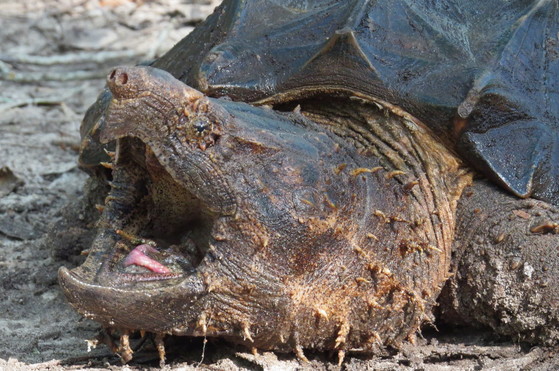 Snapper close-up. Below: sorting out a mixed catch for release. (Dirk Stevenson/Altamaha Environmental Consulting)
The pandemic didn’t stop efforts to assess Suwannee alligator snapping turtles in Georgia. Continuing species-at-risk work started in 2018, Altamaha Environmental Consulting and The Orianne Society did hoop-net trap surveys at a number of sites in the Alapaha, Withlacoochee and Suwannee River drainages last year.
The traps yielded more than a dozen Suwannee gator snappers, weighing from 22 to 83 pounds. The catches included new sites for the turtles on the Alapaha and the first photo-supported records on the New River and Suwannoochee Creek.
One hoop-net pulled from the ink-black Alapaha held a reptile hodgepodge: a 5-foot alligator, a 22-pound gator snapper, a Florida softshell turtle and two yellow-bellied sliders. Other exciting by-catch included longnose gar up to 42 inches long.
Although alligator snapping turtles – North America’s largest freshwater turtles – are now protected from harvest, some deaths occur from accidental ingestion of fishing tackle, namely hooks and monofilament line. Turtles are susceptible to getting caught by trotlines and bush hooks (also called limb lines or set hooks).
Gator snapper populations do not recover quickly. These species are slow-growing, long-lived and slow to add juveniles to boost their numbers.
-- Dirk J. Stevenson, Altamaha Environmental Consulting
WHAT YOU CAN DO
- When fishing with set hooks or sport trotlines, check them regularly and remove them at the end of the fishing day.
- If you accidentally hook an alligator snapping turtle or another protected species, carefully release it unharmed immediately. It is unlawful to capture, kill or harm protected wildlife.
- For more, see Georgia's 2021 fishing regulations.
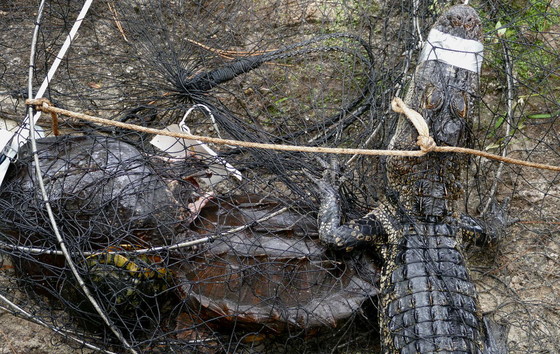
CREDITS
Masthead: Florida softshell turtle (Dirk J. Stevenson/Altamaha Environmental Consulting)
Fox squirrel pup (Kennedy Glanton/DNR)
Top
|